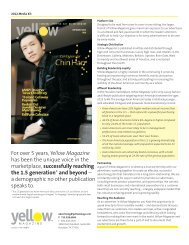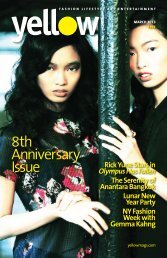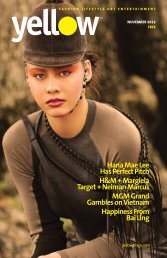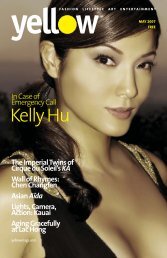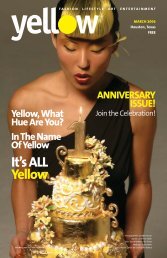Yellow Magazine Cover Model Contest Tasting Bourbon and ...
Yellow Magazine Cover Model Contest Tasting Bourbon and ...
Yellow Magazine Cover Model Contest Tasting Bourbon and ...
You also want an ePaper? Increase the reach of your titles
YUMPU automatically turns print PDFs into web optimized ePapers that Google loves.
LIQUOR<br />
The Proof Is<br />
In the Spirit<br />
<strong>Bourbon</strong> <strong>and</strong> Cognac<br />
Just in time for the holidays, <strong>Yellow</strong> <strong>Magazine</strong> had the distinct pleasure of discussing the<br />
finer points of cognac <strong>and</strong> bourbon with Courvoisier’s Quality Manager <strong>and</strong> the family<br />
representative <strong>and</strong> master distiller of Jim Bean <strong>Bourbon</strong>. It is appropriate that cognac <strong>and</strong><br />
bourbon be covered together as each is defined by strict guidelines that dictate the manner<br />
by which they are produced. Beyond the countless rules, these two spirits encompass national<br />
pride <strong>and</strong> exclusivity more than any other.<br />
Pierre Szersnovicz<br />
Quality Manager at Courvoisier<br />
6 | November 2007<br />
While cognac can only be produced in Cognac, France, bourbon can<br />
only be produced in the United States. Everything else is just br<strong>and</strong>y <strong>and</strong><br />
whiskey, respectively. In fact, France’s Jacque Chirac awarded Courvoisier<br />
the Prestige de la France, an honor bestowed upon it exclusively that<br />
establishes that the spirit is held in such high esteem as to represent the<br />
pride of the country to the world at large. It continues Courvoisier’s aura<br />
of excellence that began with the legend that it was the preferred cognac<br />
of Napoleon I <strong>and</strong> later named “Official Supplier of the Imperial Court” by<br />
Napoleon III in 1869.<br />
Pierre Szersnovicz is the Quality Manager at Courvoisier, <strong>and</strong> is the<br />
fourth generation of his family in the cognac business. His talent has been<br />
honed for more than thirty years. Today, he is one of a team of six who<br />
tastes innumerable eaux de vie on a daily basis <strong>and</strong><br />
presents their blending recommendations to the<br />
Master Blender, who is responsible for determining<br />
the final blends of cognac that the company offers.<br />
This is a process that has developed over the course<br />
of two centuries, culminating in a vocation that is<br />
itself a blend of science <strong>and</strong> art.<br />
Although all cognac is derived from Ugni Blanc<br />
grapes, the unique flavors between those produced<br />
by the different cognac houses is attributable to<br />
such factors as the number of eaux de vie blended<br />
<strong>and</strong> in what proportions, their ages, the areas from<br />
which the grapes were harvested, <strong>and</strong> the humidity<br />
in the cellars where the cognac is aged <strong>and</strong> rotated.<br />
The combination of variables is daunting, which<br />
may explain why Courvoisier’s Master Blender, Jean-Marc Olivier, is only<br />
the fourth person to occupy this critical position at the company in the<br />
last one hundred years. Consistency <strong>and</strong> experience have allowed<br />
Courvoisier to deliver the same excellent uncompromising cognac that<br />
has been savored throughout the centuries.<br />
Unlike other producers, Courvoisier selects grapes that are harvested<br />
from only four of the viticultural areas (Crus) around Cognac, France. They<br />
consider the grapes from Gr<strong>and</strong>e Champagne, Petite-Champagne, Borderies<br />
<strong>and</strong> Fins Bois to be the only ones suitable for their product. Another point<br />
of differentiation from other br<strong>and</strong>s, Courvoisier distills its cognac in<br />
smaller stills because they believe it enhances quality control.<br />
One of the most critical components of the production process is the<br />
selection of the wood used to construct the barrels in which the cognac<br />
is aged. Pierre explained, “We are very concerned about the wood. Jean-<br />
Marc Olivier is interested in selecting the wood in the forest himself. It is<br />
as important as the grapes because it is the only other ingredient that<br />
influences the flavor of the cognac. The trees may be 200-300 years old<br />
<strong>and</strong> you can see their entire history. We have found bullets from WWI<br />
embedded deep in the flesh of some. Jean-Marc looks at the trees’ history<br />
<strong>and</strong> makes his selection based on that <strong>and</strong> other characteristics.” Once<br />
the wood is selected <strong>and</strong> cut into slats, it is aged outdoors for three years<br />
before being formed into barrels.<br />
Consistency <strong>and</strong> experience have allowed<br />
Courvoisier to deliver the same excellent<br />
uncompromising cognac that has been<br />
savored throughout the centuries.<br />
Apparently, global warming has not yet damaged the process of<br />
producing cognac, as Pierre pointed out that in 30 years he has only<br />
witnessed one year in which a crop of grapes was almost unavailable. In<br />
1980, there was a severe 2-day frost, a rare event. However, he noted that<br />
when he was a child, the harvest took place in the middle of October <strong>and</strong><br />
finished in November. Today, the harvests begin in late September or early<br />
October. He stated that the tasters <strong>and</strong> Master Blender know how to blend<br />
poor vintages with superior ones, along with everything in between, to<br />
create a product that meets Courvoisier’s rigorous st<strong>and</strong>ards. So, he does<br />
not anticipate that global warming will have a significant impact. Always<br />
by HENRI MERCERON<br />
the optimist, he added, “It is better for the growers because it is much<br />
more pleasant to harvest grapes in the beginning of October rather than<br />
later. And, there is more daylight, too!”<br />
Fred Booker Noe is the sixth generation descendent of Jacob Beam,<br />
the patriarch of the family who started what would become the Jim Beam<br />
Distillery. Fred’s great gr<strong>and</strong>father did not have any sons, so his daughter’s<br />
husb<strong>and</strong>, F. Booker Noe, assumed the helm of the company. Today, Beam<br />
Global Spirits <strong>and</strong> Wine is the world’s fourth largest spirits company, with<br />
the company’s br<strong>and</strong>s including Jim Beam, Courvoisier, Canadian Club,<br />
Maker’s Mark <strong>and</strong> Clos du Bois.<br />
The origin of bourbon is both colorful <strong>and</strong> historic. Like so many of his<br />
countrymen in the northeast, George Washington produced a rye whiskey.<br />
Then, the government sought to impose a tax on the product, which is<br />
exactly what the settlers despised when they were under British rule. At<br />
the same time, the government encouraged people to move to Kentucky<br />
by offering l<strong>and</strong> upon which to grow corn to feed an exp<strong>and</strong>ing population.<br />
Many of the northeastern distillers welcomed the invitation. They harvested<br />
more corn than could be consumed <strong>and</strong> began to distill it into whiskey<br />
because it was easier to store, lasted longer <strong>and</strong> could be used as currency.<br />
In 1795, Jacob Beam sold his first batch of spirits.<br />
There are only a few variables that influence the taste of bourbon.<br />
First, the blend of grain used may be changed. By law, at least 51% must<br />
be corn; the other grains mostly used by Jim Beam are rye <strong>and</strong> barley.<br />
Second, the proof that is distilled may be varied but cannot exceed 160.<br />
When the bourbon has finished aging, de-mineralized water may be added<br />
to reduce the proof. And, finally, the degree to which the barrel is charred<br />
will affect the flavor. When I asked Fred about that, before I could get my<br />
words out he said, “Oh, it’s burnt. You get a little smoke. We use white<br />
oak, which has high sugar content. When it is heavily charred, the wood<br />
tries to heal itself by<br />
bringing the sugars to<br />
the burnt areas<br />
forming a caramelized<br />
layer. When we distill<br />
the bourbon it goes in<br />
crystal clear. We call it<br />
‘White Dog’. My dad<br />
told me that it looks<br />
white but it bites you<br />
like a dog when you<br />
drink it. And it will. I’ve<br />
drunk a little bit over<br />
the years…but we<br />
won’t go there! So, you<br />
put the White Dog into<br />
the barrel <strong>and</strong> let Fred Booker Noe from Jim Beam<br />
nature take its course.<br />
Hot summers, the fluid exp<strong>and</strong>s <strong>and</strong> penetrates the wood; cold winters,<br />
it contracts <strong>and</strong> the fluid comes out of the wood. As it passes through the<br />
caramelized layer of sugar it picks up all its color <strong>and</strong> a lot of flavors. It is<br />
the only way these can be added because nothing else is allowed.”<br />
<strong>Bourbon</strong> sales, which were flat or declining in the 1970’s <strong>and</strong> 1980’s,<br />
have made a strong comeback. Fred’s dad began releasing high-end ultra<br />
premium lines, which he said, “put the romance back into bourbon.” While<br />
people used to be loyal to the type of alcohol they drank (<strong>and</strong> even to<br />
particular br<strong>and</strong>s), the trend has been towards a diversification of tastes.<br />
Today, people will drink wine, beer, cognac <strong>and</strong> bourbon on different<br />
occasions at different times. They are more adventuresome.<br />
The company has an eye on China <strong>and</strong> Taiwan, where it introduced a<br />
Jim Beam “small batch” that is not available in the U.S. It is a bourbon<br />
finish with port wine <strong>and</strong> is for “high end consumption”. The company’s<br />
Booker bourbon is high end <strong>and</strong> has done very well in Asian markets. As<br />
it considers the emerging Chinese market, Beam’s strategy in Japan may<br />
provide a clue as to how it will market its product there. “Niko was our<br />
distributor for years. Now, Asahi is. They are the beer people <strong>and</strong> they do<br />
very well with it. If they can do for us what they’ve done for their beer,<br />
we’re going to have great market share in Japan. The thing is to partner<br />
up with existing products <strong>and</strong> draw upon the strengths of the marketing<br />
people who underst<strong>and</strong> the people <strong>and</strong> know how to sell to them.” Seems<br />
simple enough. So, how do we get the Jim Beam small batch with port<br />
wine onto our tables here? That is another story!



